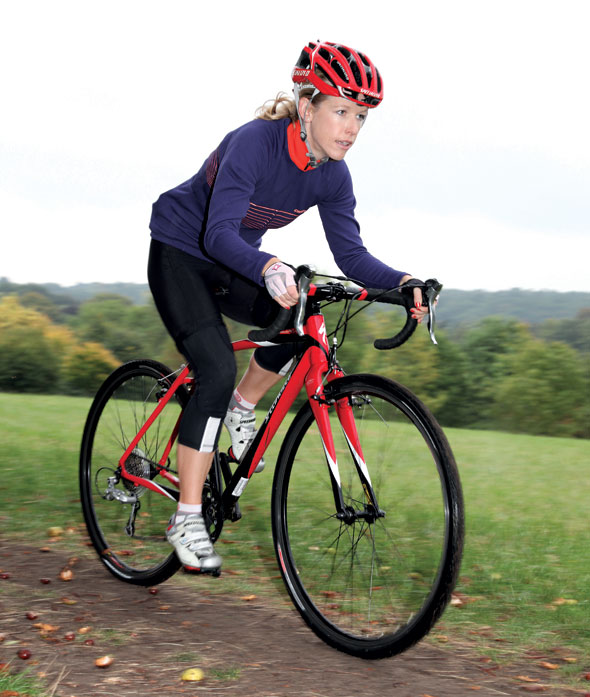group test: Specialized Crux Elite review
You can trust Cycling Weekly.

12th November 2010 Words: Derri Dunn Photos: Chris Catchpole
Back in our November/December 2009 edition, we tried Specialized’s Tricross Sport and were, to say the least, underwhelmed with its sluggish attributes. However, the decent value of the Tricross means it is far from becoming extinct in Specialized’s 2011 line-up, with the Crux cyclo-cross bike — available in one spec only or as a frameset — being brought in to complement, rather than replace the pre-existing Tricross range.
Frankly, pretty much the only thing the Crux and Tricross have in common is the cyclo-cross designation and the Specialized marque. This aside we’re really talking chalk and cheese here — the Crux has been constructed anew from the wheels up. As everybody knows, red bikes go faster than any other colour, so the Crux’s glossy rouge is a major clue about its intentions.
The geometry follows suit, with the friendly, curved spine and wavy stays of some of Specialized’s more sportive-oriented bikes abandoned in favour of aggressive, compact geometry, straight lines and tight angles. It’s also quite noticeably the lightest bike on test and all this is plenty apparent once you get pedalling. The ride is beautifully lively, responsive and, most importantly, quick, both on road and on track or grass.
A tapered steerer with 1 1/2in bearings at the bottom and 1 1/8in at the top is designed to add front-end stiffness, and certainly puts plenty of snap in the steering, even with the sort of sharp directional swings at low speed which are needed in cross or when tackling tricky off-road surfaces.
Gear-wise, there’s a good mix of the rugged and the reliable — a sturdy FSA Omega compact chainset and Deore LX rear mech picked straight from the mountain bike parts box means the most exposed movables can take a hit or two, while ubiquitous Tiagra front mech and shifters add a touch of roadie refinement.
Racing rouge
Evidently, this is very much the racer of the bunch. If you wanted to use it as a commuting and training bike, with a set of slick tyres it’ll certainly hold its own amongst the roadies, but there are few concessions to long-distance comfort. The seatpost has a Zertz insert and there’s a set of gel pads under the bar tape, useful on the cross course or over long distances due to the ultra-stiff frame and short rear stays.
Back on the cross race track, however, where you won’t be spending more than an hour on the bike, the racey performance is complemented by some nice little touches like a flat top tube section for comfortable shouldering and beautifully neat internal cable routing with secure little screw-down entry and exit ports to keep mud and water out.
Also to this purpose, frame bosses for mudguards and racks are totally omitted, again clearly designating this bike for racing rather than as a do-it-all bike as so many crossers become. But the Crux is utterly unapologetic about its lack of compromise, and rightly so. There’s nothing mongrel about this bike. It’s not a cross-breed, it’s a cross thoroughbred.
| 15 | 17 | 18 | 17 | 18 |
group test: Cross Purposes introduction
Kona Jake
Specialized Crux Elite
Genesis Croix de Fer
group test: Cross Purposes verdict
This article first appeared in the November 2010 issue of Cycling Active magazine

Thank you for reading 20 articles this month* Join now for unlimited access
Enjoy your first month for just £1 / $1 / €1
*Read 5 free articles per month without a subscription

Join now for unlimited access
Try first month for just £1 / $1 / €1
Get The Leadout Newsletter
The latest race content, interviews, features, reviews and expert buying guides, direct to your inbox!
-
 'This is the marriage venue, no?': how one rider ran the whole gamut of hallucinations in a single race
'This is the marriage venue, no?': how one rider ran the whole gamut of hallucinations in a single raceKabir Rachure's first RAAM was a crazy experience in more ways than one, he tells Cycling Weekly's Going Long podcast
By James Shrubsall Published
-
 Full Tour of Britain Women route announced, taking place from North Yorkshire to Glasgow
Full Tour of Britain Women route announced, taking place from North Yorkshire to GlasgowBritish Cycling's Women's WorldTour four-stage race will take place in northern England and Scotland
By Tom Thewlis Published
-
 Positive signs for UK bike industry as Halfords cycling sales grow
Positive signs for UK bike industry as Halfords cycling sales growRetailer admits that the impact of Donald Trump's tariffs remains to be seen
By Tom Thewlis Published